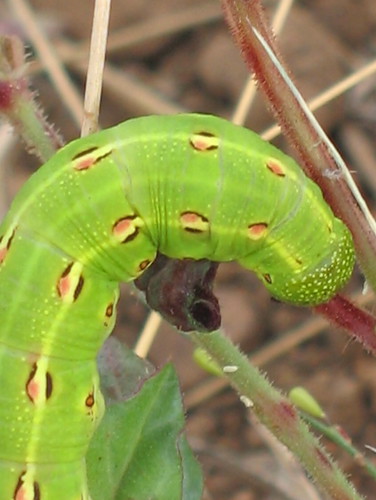
TheGardenLady received this question from Katherine.
Is there anything I can do to keep the horned worm caterpillar off of my tomatoes? I really hate those little things. My kids pick them off, but most of the time they are hidden and I can’t see them!
You may know that the horned worm caterpillar is the immature stage of
the hawk moth. It goes through a few stages, but the most damaging stage is the caterpillar stage.
Some suggestions to get rid of the pest:
Rotate the place where you plant your tomatoes. Don’t plant tomatoes in the same place every year. If you plant them in the same location year after year, insects and diseases build up in the soil which can cause problems. For example, the hornworm larvae burrow into the soil to pupate.
Remove crop residues from last year and keep the area clean of weeds. Both can encourage insects to hide, lay eggs and grow.
Check the underside of the tomato leaves in late spring to see if there are eggs deposited there by the adult moth. If you see eggs, remove the leaves and destroy them. The eggs will hatch in six to eight days and the larvae pass through five or six stages, maturing fully in three to four weeks. The fully grown larvae then burrow into the soil to pupate. That is why planting the tomatoes in different locations will help prevent a build up of hornworms in an area. The pupa may remain in the soil all winter and emerge as a moth the
following spring, or, if the weather conditions are suitable, the moth may emerge from the pupa in two to four weeks. The moths emerge from the soil, mate, and then begin to deposit the eggs of the next generation on tomato plants.
When the tomatoes have leaves, check the underside of the leaves carefully and continually for the caterpillars which can be hard to see when they are small. If, when looking for the caterpillar, you see one caterpillar, know that there are more lurking. So check all the undersides of the leaves. Use a hand held magnifying lens or look for the caterpillar’s black frass (droppings) on the foliage and around the base of the plant.
Some gardeners have some success by spraying the plants with peppermint flavoring mixed with water. TheGardenLady does not know the amount. So experiment. They say hornworms do not like the smell.
Some gardeners do companion planting. Borage planted near tomatoes is
supposed to repel tomato hornworms. Some people find that putting two or three marigolds between the tomato plants also repels hornworms as well as other problems. Marigolds, Calendula officinalis, are given a lot of credit as pest deterrents. The marigolds you choose must be a scented variety for them to work. One down side is that marigolds do attract spider mites and slugs. See here.
Planting onion sets and sage among your tomato plants may prevent beetles, bugs and tomato hornworm.
Plant one or two tobacco plants with the tomatoes. Hornworms prefer the tobacco plants and are easier to pick off. But this method only works in one location for two or three years.
Encourage beneficial insects in your yard by not using poisonous pesticides.
There is a small beneficial parisitic wasp that parisitizes the tomato hornworm. It is a Braconid wasp, Cardiochiles nigriceps. Try to attract Braconid Wasps to your garden by planting nectar producing plants that have small flowers such as dill or parsley. Because parasitic wasps feed on and eventually kill hornworms, do not kill wasp-infested hornworms. Wasp cocoons appear as white projections on the hornworm’s body. See here.
Birds and chickens love the tomato hornworm caterpillar. Encourage birds in your yard. And if your township allows, perhaps you would like to get chickens for your yard. Chickens love to eat all kinds of insects.
TheGardenLady does not recommend pesticides on gardens, especially around plants you plan on eating. But there is a relatively safe pesticide which one can use. It is a natural product known as “Bt” containing Bacillus thuringiensis. Just remember that even one as safe as Bt has negative effects – one concern is that it might kill beneficial insects as well as the hornworm. Bt can be purchased online or at nurseries.
And finally, after harvesting your tomatoes, Roto-till the soil where the tomatoes were planted. Roto-tilling the soil will destroy many of the burrowing larvae which are attempting to pupate in the soil. Tillage has shown to cause up to 90% mortality.
